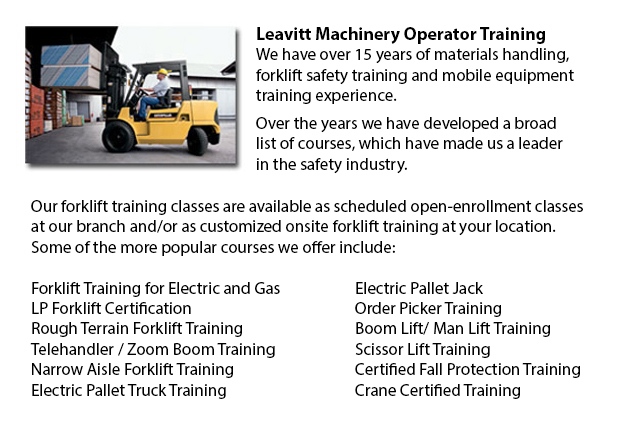
Rough Terrain Forklifts Training Mississauga - There are actually two different kinds of forklifts within the materials handling industry, the industrial model and the rough terrain model. Rough terrain forklifts first came on the market in the 1940's and were being predominantly used on uneven roads, perfect for places where no covered surfaces were available, like construction sites and lumberyards.
Usually, nearly all rough terrain lift trucks are run on a propane, diesel or gas powered internal combustion engines with a battery used for power. A number of suppliers are playing with rough ground lift trucks that make use of vegetable matter and run from ethanol. Huge pneumatic tires with deep treads distinguish these vehicles to allow them to grab onto the roughest ground type without any misstep or sliding.
A number of of the earliest versions of rough terrain lift trucks had the capability to lift in excess of 1000 lbs, by means of blades that could run beneath the item, jack it slightly and move it to an alternate site. After ten years on the market, all terrain forklifts were reinforced with additional hauling power, increasing the potential load to more than 2000 lbs. Telescoping booms were added in the 1960's, permitting them to stack resources a great deal higher than in earlier years. The telescoping model feature is a staple of most all terrain forklifts today. Present versions are capable of managing well over 4000 lbs thanks to the continuous enhancements over the years. Telescoping capability has additionally improved with some designs reaching a height of 35 feet. Worker safety has also become a focus with a lot of rough terrain forklifts now constructed are outfitted with an enclosed cab for the operator, versus the older open air seating capacity.
The rough terrain lift trucks offered these days work just as well on paved floors as on unpaved surfaces. These all terrain lift trucks are being marketed for their versatility allowing businesses to move parts from outside the facility to the inside or vice versa.
-
Reach Trucks
Reach Truck Training Mississauga - Reach trucks are loading devices used by different types of establishments that sustain a warehouse facility or circulation center relating to the organization of completed merchandise and supplies on pallets which... More -
Terex Forklift
Terex Forklift Forklift Training - Terex Forklifts takes immense pride in producing quality equipment that helps upgrade their customers' performance while standing by their mission to provide a cost effective yet reliable product line. Through sever... More -
Boom Trucks
Boom Trucks Training Mississauga - A boom truck is often recognized by the cable and telephone business vehicles that have the elongated arm folded over their roofs. Commonly, a bucket-like apparatus sits at the extension of extendable arms. Often la... More -
JLG Telehandler
JLG Telehandler Training Mississauga - After retiring in the late 1960's, John L. Grove set out on a cross country RV voyage. After spending many years establishing his family built crane business with his brother, John had no idea that this journey... More -
Doosan Forklift
Doosan Forklift Training Mississauga - Doosan Infracore Company Ltd. is an intercontinental organization consisting of Diesel Engines, Defense Industry products, Industrial Vehicles, Construction Technologies and Machine Tools and Mechanization Syste... More

Forklift Training Mississauga
TOLL FREE: 1-888-254-6157
Mississauga, Ontario
forklifttrainingmississauga.ca
Email Us
About Us


